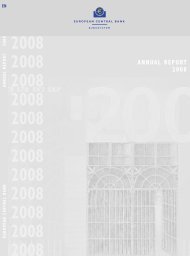Reserve Bank of Australia Annual Report 2011
Reserve Bank of Australia Annual Report 2011
Reserve Bank of Australia Annual Report 2011
You also want an ePaper? Increase the reach of your titles
YUMPU automatically turns print PDFs into web optimized ePapers that Google loves.
Risk Management<br />
Objectives and Governance Structure<br />
As a result <strong>of</strong> carrying out its central banking responsibilities, the <strong>Reserve</strong> <strong>Bank</strong> faces a broad range <strong>of</strong> both<br />
operational and financial risks. The most significant risks are those associated with the financial assets held by<br />
the <strong>Bank</strong> to underpin its operations in financial markets. However, the <strong>Bank</strong> is also exposed to significant<br />
operational risks through its banking and settlement transactions and from the administration <strong>of</strong> the<br />
organisation itself. As with most central banks, the <strong>Reserve</strong> <strong>Bank</strong> seeks to manage its risk pr<strong>of</strong>ile carefully. This<br />
reflects the view that accomplishing its public policy and other responsibilities to the expected standard<br />
would be undermined if the risks it faces were managed inadequately since this could result in significant<br />
financial losses and/or damage to the <strong>Bank</strong>’s reputation. That said, the <strong>Bank</strong> recognises that it cannot eliminate<br />
the risks involved in its activities completely.<br />
The underlying principle <strong>of</strong> the <strong>Reserve</strong> <strong>Bank</strong>’s risk management framework is that the prime responsibility for<br />
controlling and mitigating risks on a day-to-day basis lies with management <strong>of</strong> each operational area. Under<br />
this approach, line managers play a key role in identifying and assessing the risks associated with their business,<br />
including the development and monitoring <strong>of</strong> mitigating controls. Management also promotes an active risk<br />
management culture, which emphasises careful analysis and control <strong>of</strong> risk as a vital part <strong>of</strong> all business<br />
processes in the <strong>Bank</strong>.<br />
Oversight <strong>of</strong> the <strong>Reserve</strong> <strong>Bank</strong>’s arrangements for risk management is undertaken by the Risk Management<br />
Committee. This is a committee <strong>of</strong> senior executives responsible for ensuring that all the risks facing the<br />
organisation, with the exception <strong>of</strong> those arising directly out <strong>of</strong> the <strong>Bank</strong>’s monetary, financial stability and<br />
payments policy functions, are properly evaluated and managed. It is chaired by the Deputy Governor and<br />
comprises the Assistant Governors for <strong>Bank</strong>ing and Payments, Corporate Services, Currency and Financial<br />
Markets; the Chief Financial Officer; the Heads <strong>of</strong> Audit, Human Resources and Risk Management; and the<br />
General Counsel and Deputy Secretary. The Committee meets every three months, or more frequently if<br />
required, and informs the <strong>Bank</strong>’s Executive Committee and the Board’s Audit Committee <strong>of</strong> its activities. The<br />
Risk Management Committee is supported in its responsibilities by the Risk Management Unit (RMU). The<br />
RMU’s main role is to help groups and departments manage their risk environment in a manner which is<br />
broadly consistent across the <strong>Bank</strong>. The RMU also monitors performance and risk associated with the <strong>Bank</strong>’s<br />
activities in the financial markets.<br />
The Audit Department co-ordinates closely with – but remains separate from – the RMU. Audit provides an<br />
independent assurance that the <strong>Bank</strong>’s risk management framework is effective and applied across the <strong>Bank</strong>.<br />
The Audit Department also has a separate brief to test the adequacy <strong>of</strong> procedures and controls at all levels <strong>of</strong><br />
the <strong>Bank</strong>. The RMU itself is subject to audit review. The Audit Department reports to the Board’s Audit<br />
Committee, which meets quarterly or more frequently if required.<br />
As noted, the <strong>Bank</strong>’s risk management policy covers financial, market, credit, operational and other risks<br />
inherent in carrying out its central banking activities, but not the risks associated with the <strong>Bank</strong>’s core monetary,<br />
financial stability and payments policy functions. These remain the responsibility <strong>of</strong> the Governor and the<br />
<strong>Reserve</strong> <strong>Bank</strong> and Payments System Boards. Governance <strong>of</strong> the business risks in Note Printing <strong>Australia</strong> Limited<br />
ANNUAL REPORT <strong>2011</strong> | Risk Management<br />
53





![KNOW YOUR NEW GIBRALTAR BANKNOTES - [Home] bThe/b](https://img.yumpu.com/50890985/1/184x260/know-your-new-gibraltar-banknotes-home-bthe-b.jpg?quality=85)
![PAPUA NEW GUINEA - [Home] - Polymer Bank Notes of the World](https://img.yumpu.com/49758743/1/190x143/papua-new-guinea-home-polymer-bank-notes-of-the-world.jpg?quality=85)










